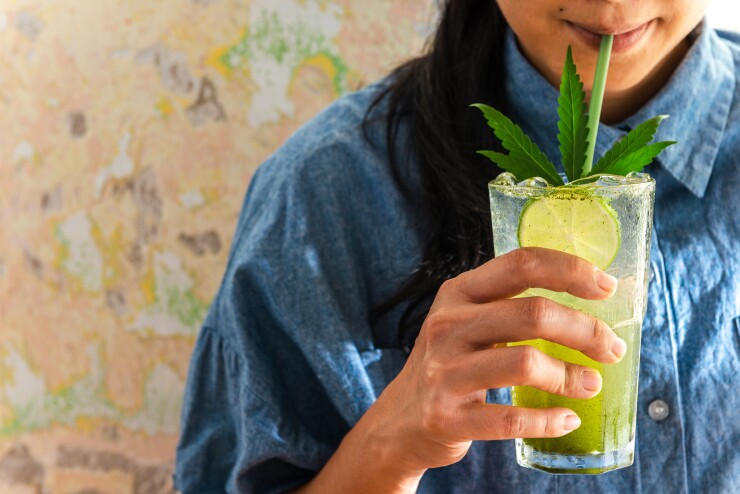As THC-infused beverages make their way across the average bar, hospitality teams are considering how this innovation thrusts their business into uncharted risk territory.
The cocktail world thrives on creativity, and today's bartenders are going beyond bitters and botanicals to offer a new trend: THC infused drinks. Thanks to the 2018 Farm Bill legalizing hemp across the country, cannabis is making its way into cocktail culture in the form of cans, tinctures, tonics, even infused wines. THC beverages are being offered on traditional bar menus, adding new layers of flavor, novelty, complexity - but also nuance and potential challenges.
But unlike a regular's splash of vermouth or a perfectly predictable twist of citrus, cannabis brings with it a host of unfamiliar responsibilities and logistical issues, from dosages and labeling to staff training and legal liability. While interest is growing among consumers, many bars and restaurants are still catching up on how to serve these products safely and compliantly, especially in states where consumption laws remain vague or nonexistent.
Straight from the cooler
Hemp-derived THC beverages, which are a widely unregulated product, are now showing up in taprooms, cocktail bars, and even quick-service locations like gas stations and convenience stores nationwide. Meanwhile, licensed THC drinks that are produced and sold through adult-use state-regulated cannabis channels are available through licensing programs in states like California and Minnesota.
For bartenders, they present a fresh canvas. But they also come with rules, unpredictability, and it's not always clear where the risks lie.
Bartenders are already masters of their craft: measuring liquors, crafting delicious concoctions, and providing high quality service to patrons. But cannabis may throw a wrench into their otherwise perfectly balanced operation.
THC affects everyone differently, and unlike alcohol, it can take 30 minutes to up to 2 hours to feel the full effects. That delayed onset complicates responsible service and makes overconsumption harder to detect in real time. Bartenders accustomed to judging impairment by slurred speech or glassy eyes might miss early signs of cannabis intoxication.
Add to that the need to communicate dosage to consumers who may be otherwise unfamiliar with cannabis or hemp. In most THC drinks, potency is measured in milligrams and what seems like a small amount can be more than expected. For guests, that information should be clearly on the menu and explained by the staff.
Cannabis products need to be clearly labeled and servers should conduct ID checks. Guests should never be confused about what's in their glass, how much THC it contains, or how long it might take to feel - underscoring the need for all servers and bartenders to receive education in safe service.
Regulatory gray areas
One of the biggest challenges is that consumption laws haven't caught up with consumer demand for THC drinks. In many states, it's not clear if they can be consumed on premises at all. There's also confusion around whether alcohol and THC can be served together, given their increased risk as intoxicating products.
Bars experimenting with cannabis drinks must work closely with their legal counsel and local regulators to understand what they are allowed to sell. In some states, selling THC beverages alongside alcohol may violate licensing rules or create new compliance requirements. In others, there may be no guidance at all, which leaves operators to make tough judgment calls about risk and liability.
Safety and compliance best practices
Bars that decide to move forward with THC beverages should treat them with the same procedures as liquor. This includes focusing on:
- Staff training: Educate bartenders and servers on how cannabis works, how to explain onset and dosage, and how to identify signs of overconsumption.
- Clear labeling: Make sure menus include THC content, serving size, and how long it takes to feel effects.
- Separate liquor and THC drinks: Consider limiting which staff can serve hemp beverages or sell only during specific hours of the day, limiting risk.
- Keep storage locations secure: Just like top-shelf liquor, cannabis products should be stored safely and kept out of reach when not in use.
- Identify strong policies: Ensure your insurance policies reflect your full menu offerings, and check for exclusions.






